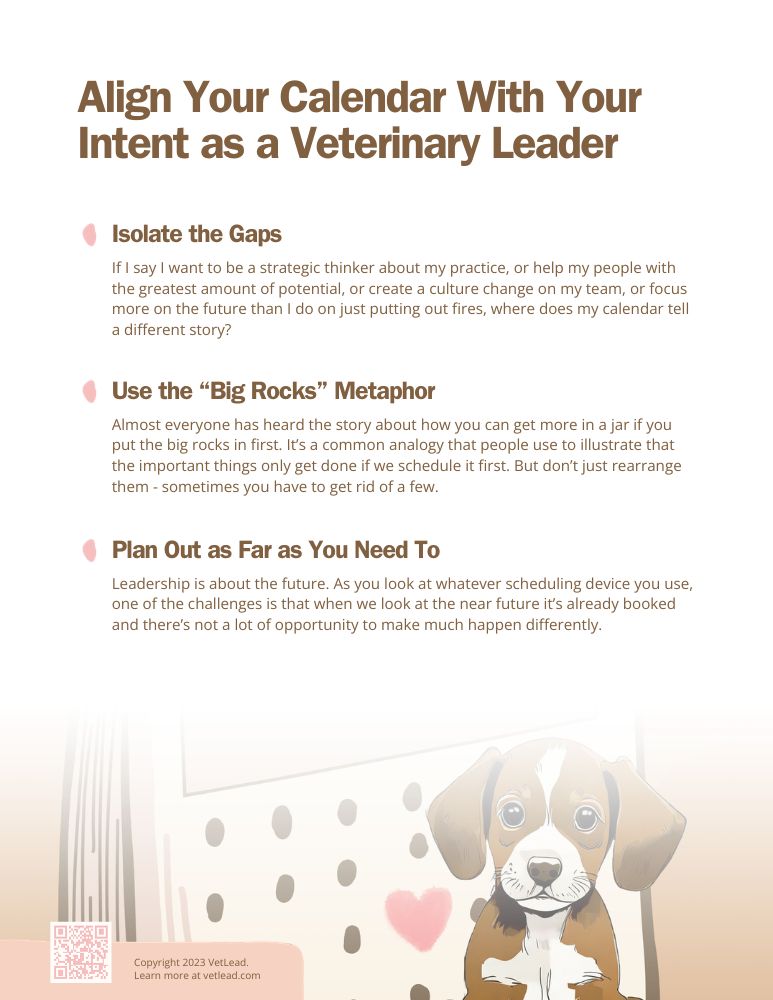One of the best parts of my job is being able to work with veterinary practice leaders as a coach to help them achieve more of their goals, chart their career course, and build stronger, more accountable teams around them.
Each leader is unique. They face different challenges, have different opportunities, and different sets of patterns, habits, and experiences.
After literally thousands of coaching conversations, however, several themes have emerged. One of the most common themes I see is the gap between what a person would like to happen, and what they have planned to make happen.
Awareness and Intention Are the First Steps
Often leaders will have the intention to make a change, do something different, be more strategic, spend more time with their people, or less time on the chaos. A question I often ask at that point is, “Does your calendar look significantly different for the next month than it did for the last month in terms of what it prioritizes?”
Awareness and intention are the first steps to change. However, sometimes it stops there. Your calendar is often a very accurate reflection of whether change is or is not being implemented.
How You Spend Your Time Matters
On a few occasions, I have had the opportunity to shadow leaders as they go about their job. It quickly becomes evident what their priorities are based on the way they spend their time.
It’s very easy to see any gaps between stated priorities and evident ones. But job shadowing is not always possible in a coaching environment. So, the next best thing is to take a look at the calendar.
Here are a few things to think about as you look at your intentions as a leader and compare that to your schedule.
1. Isolate the Gaps

If I say I want to be a strategic thinker about my practice, or help my people with the greatest amount of potential, or create a culture change on my team, or focus more on the future than I do on just putting out fires, where does my calendar tell a different story?
Have I scheduled time to do any of those things? It’s important to understand the changes you want to make as a leader. But you must also schedule time to make those changes happen.
Find the Time You Need
One of the most common struggles I hear is, “I don’t have time to lead differently because I’m just getting through the day.” The first step to fixing that is put time on the calendar to do something different. If you can’t do it next week, do it the week after that or next month.
There must be some time in the future that isn’t already filled with something else. Block it, schedule it, label it now so that we start to carve time for what we say is important.
2. Use the “Big Rocks” Metaphor

Almost everyone has heard the story about how you can get more in a jar if you put the big rocks in first. It’s a common analogy that people use to illustrate that the important things only get done if we schedule it first.
However, this is a little misleading. Sometimes we can’t just rearrange the rocks, we actually have to get rid of a few. When there are things on our schedule ahead of time, it’s not that we don’t ever change them or move them or allow them to shift because something urgent comes up. Rather, as humans our behavioral patterns cause us to do different things if we concretely plan different things to do.
Set Yourself Up to Make Changes
We are simply more likely to make changes, shift how we spend our time, and focus on different things if we think consciously about them ahead of time rather than just let the days get filled up with whatever comes our way.
If we put a meeting on the calendar next month to discuss or review a strategic plan with our team, we will usually focus on it more between now and then. We will discuss it with others, make time to think about it, write some things down and in general, be more strategic because we simply put being more strategic on the calendar.
3. Plan Out as Far as You Need To

Leadership is about the future. As you look at whatever scheduling device you use, one of the challenges is that when we look at the near future it’s already booked and there’s not a lot of opportunity to make much happen differently.
We have meetings, projects to be complete, and commitments to keep. But there are very few of us that can’t look a month, two months, or even six months out and find time to make changes. Ironically, wanting to get something on the calendar helps us be creative about our shorter-term window.
Align Your Calendar with Your Intent
If we haven’t spent time with a high potential employee but all of our time has been spent with the poor performer on our team, then we look at our calendar with the intent to change that. If we never look at our calendar to align our intent with our time, we never find that opportunity.
If we absolutely cannot fit that in, then scheduling a monthly lunch with that person starting three months from now and continuing for six months after that will still yield different and better results over the next year.
Closing Thoughts
Aligning our calendar with our beliefs about how we should lead takes advantage of our ability as humans to change habits and patterns only if we first think about things consciously rather than deal with them reactively.
It’s about choosing a different future because then we can figure out how to make a different future happen. It’s about setting goals and making plans because it causes us to think differently and that changes behavior today even if the goal is a year or two out there.
Write down your leadership intentions for the future. Then, look at your calendar and see if the two match. If they don’t, that’s where that whole “road paved with good intentions” saying comes from. Time is all we have to create change with. What we do with it matters.
What does your calendar look like? Let us know in the comments.

Download this Accompanying PDF Now
Share it with leaders and teams. No email address required.

[…] Once goals are set, schedule them in. Scheduling isn’t just for appointments; it’s a way to prioritize yourself. Schedule time for recharging, […]